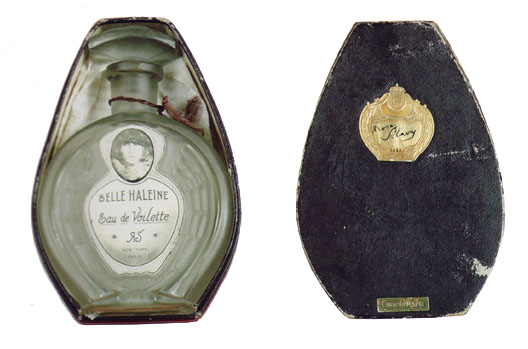
Belle Haleine eau de Voilette
or
Beautiful Breath: Veil Water
|
Original Version:
1921, New York |
 |
| Original version, 1921 |
Essentially a Rigaud brand perfume bottle, this Readymade was altered in several ways by Duchamp and his close friend and fellow artist Man Ray. First of all, Duchamp removed the original label and replaced it with a new one created specifically by him and Man Ray. (In this way, there actually was making involved in this piece. Hence, its frequent categorization as an assisted readymade is justified.) Man Ray took the photograph of Duchamp dressed as his female alter ego "Rrose Selavy," which stands at the top of the new label. This was the first visual appearance of Rrose Selavy. Several months earlier, Rrose first appeared when Duchamp signed the Readymade Fresh Widow with her full name. In a noticeably unretouched image and unconvincing drag, Man Ray and Duchamp supply a "notably gawky and awkward" visual representation to complement the name on Belle Haleine (Fillin-Yeh 101).
This "image sandwich of female and male" seems appropriately ironic when one considers the meaning of the "woman's" name (Fillin-Yeh 101). The name "Rrose Selavy" itself is a pun on the famous French phrase "Eros, c'est la vie!" or "Love, life!" Nothing is truly as it seems; hidden meanings and identities are disguised and revealed at the same time by visual facades. In the same way that L.H.O.O.Q.'s Mona Lisa, with her goatee and moustache, is not a woman but a man, Rrose Selavy is not Marcel, but a woman.
Duchamp and Man Ray replaced the original inscription on the label ("Un air qui embaume") with the words that comprise the title of the piece. The original bottle label read "Eau de Violette" or "Violet Water." In his typical attention to linguistics, Duchamp switched two vowels in the name to achieve the final "Eau de Voilette" or "Veil Water" (Schwarz 216). "Voilette" is a combination of violet and the French word "velito" (or "little veil"). This idea of veiling further highlights the layers of meaning of this Readymade.
Finally, and perhaps most importantly, Duchamp transformed the "R" standing for Rigaud into "RS" - the initials of Rrose Selavy. The "R" appears backwards, as if reflected in a mirror. This effect could have innumerable meanings, including an attempt to further involve and implicate the viewer.
The concepts of authorship and identity of the artist truly are in flux in Belle Haleine. Rrose Selavy not only serves as a main visual element of this piece, but she also stands as the (or an) artist. A gold label on the back of the box holding the perfume bottle reads: "Rrose/Selavy/1921 [signed after 1945]." This signature, denoting Rrose as the artist, further supports the argument that Duchamp was anticipating a gendered interpretation.
The first complication posed is that of course Rrose is really Duchamp himself disguised. Therefore, Duchamp fills the role of artist. However, one must consider that the piece is a collaboration. Duchamp himself stated that Man Ray drew the letters on the label (Schwarz 687). Thus it seems the two men are co-authors. Although, there is one last author question: if this is a perfume bottle, then isn't the Riguad perfume company, or popular culture in general, the artist as well? Its appears that none and all of the aforementioned are the true artist/author of this piece. It seems that this duplicity in authorship (which surely depends strongly upon the viewer's perspective) may have been Duchamp's way of getting the onlooker to turn into an on"thinker" - to not just look, but start thinking about the nature of art (and, in this case, the concept of authorship and role of the artist).
There are many sexual interpretations of this piece; under close inspection, this perfume bottle quickly becomes a gender-loaded object. It may easily be suggested that the concept of perfume trapped in a phial, where it can't be seen, is an allusion to the smell of female genitalia. By incorporating the ideas of breath, smell, and temperature, Belle Haleine links itself closely with ideas of sexual intercourse and arousal. It suggests that sexual arousal depends on much more than just looking (Ramirez 52). Belle Haleine thus draws a parallel between artistic and sexual experiences. Essentially, in both contexts, pleasure is derived not only from looking, but also from smelling, touching, and tasting. Duchamp also introduces gender binaries through his focus on Rrose Selavy.
Belle Haleine stands as one of the most critical Readymades in Duchamp's oeuvre. Schwarz's (perhaps over)attention to it in his The Complete Works of Marcel Duchamp illustrates this well. Schwarz notes that the label was originally made as a larger scale collage, only later to be reduced in scale and attached to the bottle. As a result, he not only discusses the bottle as a Readymade, but also treats the label as a separate "imitated rectified readymade," unattached from the substance it labels (687). For the purposes of this exhibition, however, both of these Readymades have been combined into one entry.